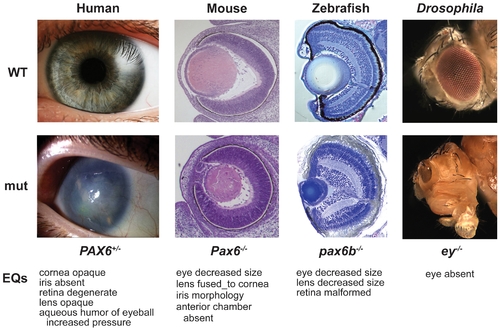- Title
-
Linking Human Diseases to Animal Models Using Ontology-Based Phenotype Annotation
- Authors
- Washington, N.L., Haendel, M.A., Mungall, C.J., Ashburner, M., Westerfield, M., and Lewis, S.E.
- Source
- Full text @ PLoS Biol.
|
Representation of phenotypes. Phenotypes of wild-type (top) and PAX6 ortholog mutations (bottom) in human, mouse, zebrafish, and fly can be described with the EQ method. EQ annotations of the abnormal phenotypes are listed below each set of images per organism. Note that the anatomical entities are from ssAOs and qualities are from the PATO ontology. These PAX6 phenotypes have been described textually as follows. Human mutations may result in aniridia (absence of iris), corneal opacity (aniridia-related keratopathy), cataract (lens clouding), glaucoma, and long-term retinal degeneration. For mouse, the mutants exhibit extreme microphthalmia with lens/corneal opacity and iris abnormality, and there is a large plug of persistent epithelial cells that remains attached between the cornea and the lens. For zebrafish, the mutants express a variable and modifiable phenotype that consists of decreased eye size, reduced lens size, and malformation of the retina. Drosophila ey (a PAX6 ortholog) mutations cause loss of eye development. The genotypes shown are E15 mouse Pax614Neu/14Neu [68], 5 day zebrafish pax6btq253a/tq253a [69], human PAX6+/- [70], and Drosophila ey-/- [71]. |

